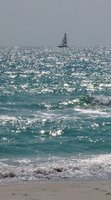 when she strolled out onto the sand and set up her chaise.) What I needed was some way to keep track of time so I could tell how long I had been out there.
when she strolled out onto the sand and set up her chaise.) What I needed was some way to keep track of time so I could tell how long I had been out there.Ancient technology has always intrigued me. Tools have been of greater interest that the products produced by them. I bore people by wondering why it is that museums display thousands of sculptures and carefully carved wooden objects but not the gouges, files and chisels required to make them. Art is not what sets us apart as a species, it is our use of tools. Art is just another by-product of that use of tools . For me, the more basic, the more primitive a tool, the better I like it. My dad had, and I still have, this tear shaped chunk of steel. It was the perfect sheet metal working tool, he said, sharp at one end and nicely rounded at the other, one could use all of it's contours to shape anything else into anything else. I didn't really appreciate what he was talking about until years later while browsing through the Metropolitan Museum of Natural History, I saw reproductions of the first stone tools found in Africa. Tear-shaped, looking just like this comma , it was dad's tool unchanged for 3 and a half-million years..., you could use the sharp end to chop the end of a lance or scrape the meatside of a skin. the round end makes a perfect hammer, drive a stake or bust open a marrow bone.
So I decided to make a sundial on the beach. It's another primitive technology that I have some grasp of, no pun intended. I found the perfect stick and luckily there was someone going by who had a watch, so I got a pretty good reference for high noon. (Yeah, it's cheating, but this is experimental science on a zero budget.) Shells were collected to mark the hours and I settled in to listen to my book and watch the boats, girls and gulls go by.
I once wrote a story about a survivor of an airplane crash in the far North woods of Idaho who tries to signal his whereabouts to rescuers by starting a fire signal everyday at noon. He gets North by looking a the moss side of trees and sets a stick in the sunshine every morning when he wakes up. When the shadow is at it's shortest, he lights up the nearest sap-filled pine tree. When no rescue arrives he moves Southward until darkness falls and then does the same thing again the next day. It takes ten days, and two raging forest fires, before anyone at the search end of things to notice the regularity. They come and get him before he can burn his way to Boise.
So I fell asleep on the beach and I missed one o'clock, the little FM radio I have said it was 2:10 (more cheating, uh, outside reference use.) So I got up and marked where the two would be. Then, more reading, listening, to my book. Which is the problem, the book, it's Theocracy and even though I am interested in the subject matter - the influence of religion on American politics - almost the whole of Part One is a recitation of the growth of churches by percentages. Paragraph after paragraph of "increased by nearly six percent between 1865 and 1877...". ZZZZZZZzzzzzzzzzzz. Huh?
Now the sun seems to have moved a great deal across the sky and a quick check -"Excuse me, Miss Brown-as-a-JimmyDean-Extra Lean, do you know what time it is?"..proved to be-------- not as much as I had thought. It was only 3:20 but the shadow had moved twice as far as it had between noon and one and nearly three times as far- if her watch was right- between two and three. What the hey?
So I got up and marked three o'clock or so and then called it a day, but I went inside to find out what the deal was. Here it is. The ancients figured out what I did. The spacing between the hours was never the same, AND, as I would find out the next day, the sun moves down the horizon every day so you would have to adjust for that too, otherwise in a couple of weeks even your noon would be wrong. What they did was two things: they tilted the base of the dial so that it matched the angle of the sun's travel and they re-aimed the thing every day to follow the season. Except at Stonehenge, there they had the big gates to look through as the sun traveled, but it was more of a yearly calendar than a watch.
A much more complicated observation of time could be made by the astrolabe invented around 150 BC, (sigh, later condemned as an instrument of the devil by the Church, another in a long line of errors by the inerrant.), it shows the depth of knowledge achieved by the most ancient of our ancestors.
So I found out that the simple technology of the sundial is not so simple, and I had a good nap.
Next I intend to show how easy it is to control the wind.
3 comments:
sigh, later condemned as an instrument of the devil by the Church, another in a long line of errors by the inerrant.
Uh, maybe those self-defined as inerrant.
TCH-TX
There is no other kind.
i am glad we don't have to reinvent things all the time. if we did, my wagon would probably have square wheels. i applaud your skill in stick-watching!
Post a Comment